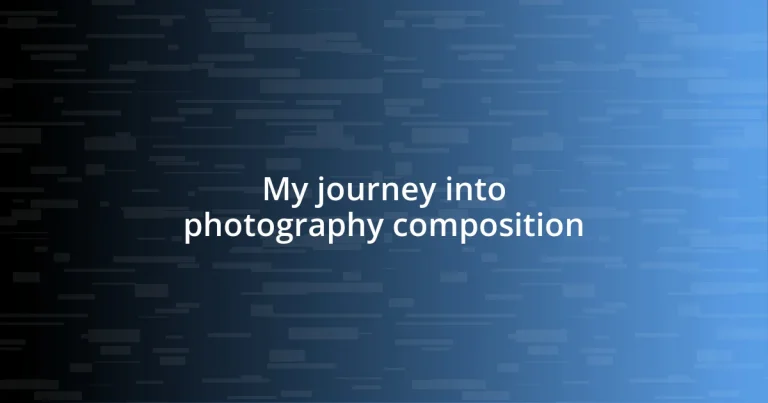Key takeaways:
- Photography composition is essential for creating engaging images, utilizing principles like the rule of thirds, leading lines, and balancing negative space.
- Key elements such as color, texture, and contrast significantly influence the emotional impact of a photograph, transforming simple snapshots into profound narratives.
- Developing a unique photographic style involves intentional choices, experimentation, and personal storytelling, reflecting one’s individual journey and emotions.

Understanding photography composition
Photography composition is the art of arranging elements within a frame to guide the viewer’s eye and evoke emotions. I remember my early days fumbling with my camera, frustrated by what felt like chaotic images. It wasn’t until I learned to observe my surroundings with an intentional eye that I discovered the power of framing my shots thoughtfully.
Consider the rule of thirds, a fundamental guideline in composition that divides an image into thirds, both horizontally and vertically. Placing subjects along these lines can create more dynamic and engaging photographs. I still recall a moment when I placed a lone tree along one of these lines during sunset. The result was a striking image that captured both the serenity and grandeur of the scene in a way that simply centering the tree wouldn’t have achieved.
Incorporating leading lines, such as roads or pathways, can also draw your audience deeper into the photograph. Have you ever noticed how a winding path can evoke a sense of journey? I find that when I incorporate such lines in my work, it instills a feeling of adventure, inviting the viewer to explore what lies ahead. By thoughtfully considering these compositional elements, we can transform our photography into powerful narratives that resonate with others.

Key principles of composition
When diving into photography composition, I’ve discovered that balancing negative space alongside your subject can enhance visual storytelling. I vividly remember a photo I took of a child playing in a vast field, with plenty of empty space around them. It not only emphasized their joy but also evoked feelings of freedom and open possibilities. That contrast made the viewer pause and really absorb the emotional weight of the moment.
Here are a few key principles of composition to keep in mind:
- Rule of Thirds: Divide your frame into a grid of nine squares, placing key elements along the lines or at their intersections for balance.
- Leading Lines: Use natural lines in the scene, like roads or fences, to guide the viewer’s eye toward a focal point.
- Framing: Position elements within the scene to create a “frame,” adding depth and focus to the main subject.
- Symmetry and Patterns: Seek out symmetry in your compositions, or highlight repetitive patterns to create visual harmony.
- Depth and Layering: Incorporate foreground, middle ground, and background elements to add a three-dimensional feel to your images.
Each of these principles can create a unique emotional resonance, transforming an ordinary snapshot into a compelling story. I’ve found that by experimenting with these ideas, I begin to see composition as an exciting playground rather than a set of strict rules.

Essential elements of visual design
Visual design in photography hinges on a few essential elements that can truly elevate an image. Take color, for instance. I remember a time when I shot a vibrant market scene, saturated with hues of red and yellow. The colors not only made the image pop but also conveyed the lively energy of the locale, making the viewer feel as if they were amidst the hustle and bustle. It’s amazing how color palette choices can evoke specific moods and emotions.
Another critical element is texture. In one of my portraits, I captured a weathered face with deep lines and rough skin, which told a story of a life well-lived. This texture added a layer of authenticity and depth that a smooth canvas could never achieve. It’s funny how details that might seem insignificant can transform a simple photo into a profound narrative.
Lastly, contrast plays a vital role in guiding the viewer’s eye. I recall using high contrast in a black-and-white photo of a dancer in motion. The sharp differences between light and dark emphasized the grace and power of her moves, creating a striking visual impact. Each of these elements intertwines, creating a coherent story that draws the viewer in, making them feel the emotions behind the image.
| Element | Description |
|---|---|
| Color | Used to evoke emotions and can transform the mood of an image. |
| Texture | Adds depth and authenticity, allowing a photograph to tell a deeper story. |
| Contrast | Highlights differences in light and shadow, guiding the viewer’s eye to key points. |

Techniques for framing your shot
When I first started taking photos, the way I arranged my subjects in the frame felt almost instinctual. I remember a time I captured a sunset, and I instinctively framed the sun peeking through a cluster of trees. That simple act of framing not only isolated the beautiful light but also created an intimate moment in nature, inviting the viewer to share in that personal experience.
Framing can be as subtle or bold as you desire. For instance, using elements like doorways or arches not only draws the eye but also creates layers in the image, which I found particularly effective during a city stroll. As I snapped a shot of an old building, the archway created a striking border that added depth and context to the shot. It was a reminder that sometimes our surroundings can work as collaborators in our storytelling.
Have you ever captured something beautiful but felt it just didn’t translate well onto the photo? I once took a picture of a bustling café scene but ended up feeling overwhelmed by the clutter in the frame. It taught me that framing can eliminate distractions and focus attention where it matters most. By strategically selecting how to frame each shot, I’ve learned to better communicate the essence of what I’m observing, creating images that resonate with my feelings and experiences.

Utilizing light and shadow effectively
Utilizing light and shadow in photography can transform an image from ordinary to extraordinary. I remember wandering through an abandoned factory one afternoon, stumbling upon a shaft of light breaking through the slats. The way it illuminated the dust dancing in the air was nothing short of magical, creating layers of shadow that added depth and mystery to my photograph. Isn’t it fascinating how a simple play of light can evoke feelings of nostalgia or curiosity?
Shadows, often overlooked, hold incredible potential to enhance composition. I once captured a street scene at dusk where the long shadows of pedestrians elongated across the cobblestones. These shadows not only provided context but added drama to the image, almost narrating an untold story. Have you ever noticed how shadows can guide your eye and create tension in a frame? This subtle interplay can breathe life into your work, shaping narratives that mere objects cannot convey.
I find that understanding the direction of light is crucial. For a while, I struggled with portraits until I began experimenting with backlighting. One day, I decided to photograph a friend during golden hour, with the sun setting behind her. The results were stunning; the rim light outlined her silhouette and created a halo effect that felt both ethereal and intimate. When light meets shadow in a dance, it tells a story that connects the viewer more deeply to the subject.

Creating a balanced image
Creating a balanced image involves more than just simple symmetry; it’s about distributing visual weight to capture a viewer’s attention effectively. I remember experimenting with the rule of thirds while photographing a serene lake at dawn. By placing the horizon on the upper third of the frame, I was able to emphasize the peaceful water below, which felt like I was giving the viewer an invitation to experience that calmness firsthand.
One technique I often turn to is consciously placing elements within the frame to achieve harmony. For instance, last spring, while wandering through a vibrant flower garden, I shot a close-up of a single bloom. To balance the image, I included a blurred bud in the corner; it drew the viewer’s eye around the frame, creating a sense of unity. Have you ever experienced a moment when a small detail transformed your entire perception of a scene? That’s the magic of conscious composition!
The emotional connection I felt with my subjects has significantly influenced my approach to creating balanced images. When I captured a candid shot of children playing, I positioned them slightly off-center to lead the viewer’s eye through the happiness of their discovered joy. Balancing the action with negative space felt not only aesthetically pleasing but emotionally resonant, making the photograph a vibrant snapshot of pure joy. Isn’t it incredible how balance can evoke feelings and tell stories without uttering a single word?

Developing your unique style
Developing a unique style in photography is an evolving journey that often reflects who we are as individuals. I remember the first time I experimented with double exposure; capturing a silhouette of a dancer superimposed against a bustling city skyline felt like combining my love for movement and urban life. This technical adventure opened my eyes to how personal stories can shape creative choices, prompting me to ask myself: What does my work say about me?
Finding that unique voice isn’t always easy—it often requires a lot of trial and error. I had my fair share of awkward moments, like when I tried to imitate a popular photographer’s work only to realize it felt forced and inauthentic. Through that process, I learned to embrace my quirks. Now, I intentionally seek out unexpected moments, like a candid laugh during a serious family portrait session, to let my genuine personality shine through. Wouldn’t you agree that the most memorable photos are often those that capture real emotions?
As I continue on this artistic path, I’ve come to appreciate the power of intentionality in style development. For instance, I often use muted colors to evoke a sense of nostalgia, as seen in my recent series of foggy landscapes. That decision wasn’t just random; it was rooted in childhood memories of misty mornings spent exploring nature with my family. Each image speaks to a broader narrative—one that invites viewers into my experience and encourages them to reflect on their own stories. How does your style reflect your personal journey? Understanding that connection is key to developing a distinctive photographic voice.












